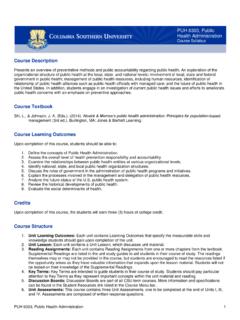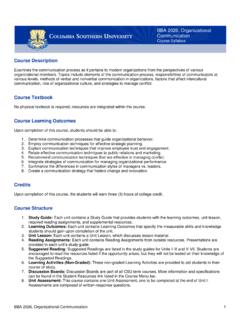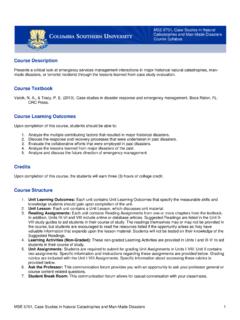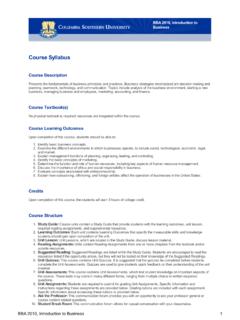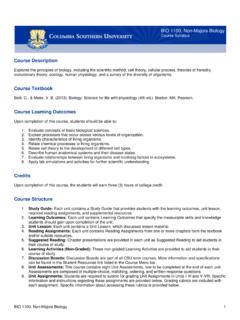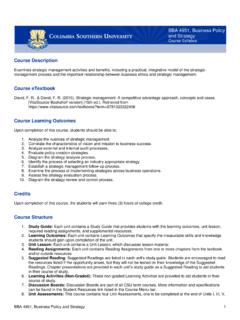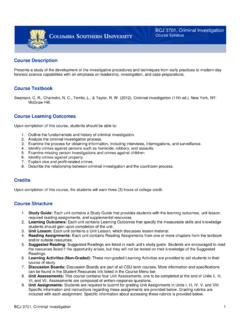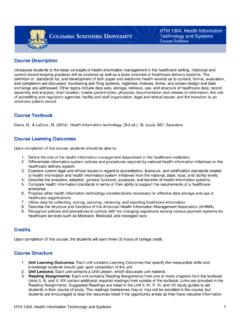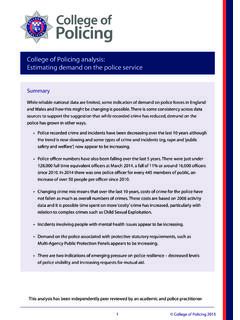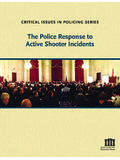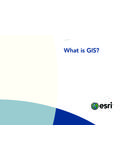Transcription of BCJ 4101, Police and Community Relations - Login
1 BCJ 4101, Police and Community Relations 1 Course Description Examines the history of Community policing , problem-oriented policing , Community responsibilities, media Relations , and evolving strategies. Students analyze criminal justice organizations including human resources management, research studies, environmental factors, centralized authority, and other issues. Course Textbook Miller, L. S., Hess, K. M., & Orthmann, C. H. (2014). Community policing : Partnerships for problem solving (7th ed.). Clifton Park, NY: Delmar Cengage Learning. Course Learning Outcomes Upon completion of this course, students should be able to: 1. Explain how the United States Constitution makes the role of American law enforcement different from other countries. 2. Examine the three eras of policing in the United States and how Police / Community Relations have changed from era to era. 3. Assess the viability of the broken windows theory in the 21st century.
2 4. Explain how the SARA Model (scanning, analysis, response, assessment) can be applied in various forms of policing . 5. Explain the importance of a good relationship between law enforcement and the media. 6. Discuss Police - Community relationships regarding the media, gangs, and the process of assimilation. 7. Analyze impediments to Community policing . 8. Explain why CPTED (crime prevention through environmental design) and Weed and Seed programs are important to neighborhood safety. 9. Analyze violence, crime, and vandalism in schools. 10. Examine the use of excessive force by Police and citizen complaints. Credits Upon completion of this course, the students will earn three (3) hours of college credit. Course Structure 1. Study Guide: Each unit contains a Study Guide that provides students with the learning outcomes, unit lesson, required reading assignments, and supplemental resources. 2. Learning Outcomes: Each unit contains Learning Outcomes that specify the measurable skills and knowledge students should gain upon completion of the unit.
3 3. Unit Lesson: Each unit contains a Unit Lesson, which discusses lesson material. 4. Reading Assignments: Each unit contains Reading Assignments from one or more chapters from the textbook and/or outside resources. 5. Suggested Reading: Suggested Readings are listed in each unit s study guide. Students are encouraged to read the resources listed if the opportunity arises, but they will not be tested on their knowledge of the Suggested Readings. BCJ 4101, Police and Community Relations Course Syllabus BCJ 4101, Police and Community Relations 2 6. Learning Activities (Non-Graded): These non-graded Learning Activities are provided to aid students in their course of study. 7. Unit Assignments: Students are required to submit for grading Unit Assignments in Units I-VIII. Specific information and instructions regarding these assignments are provided below. Grading rubrics are included with each assignment. Specific information about accessing these rubrics is provided below.
4 8. Ask the Professor: This communication forum provides you with an opportunity to ask your professor general or course content related questions. 9. Student Break Room: This communication forum allows for casual conversation with your classmates. CSU Online Library The CSU Online Library is available to support your courses and programs. The online library includes databases, journals, e-books, and research guides. These resources are always accessible and can be reached through the library webpage. To access the library, log into the myCSU Student Portal, and click on CSU Online Library. You can also access the CSU Online Library from the My Library button on the course menu for each course in Blackboard. The CSU Online Library offers several reference services. E-mail and telephone ( ) assistance is available Monday Thursday from 8 am to 5 pm and Friday from 8 am to 3 pm. The library s chat reference service, Ask a Librarian, is available 24/7; look for the chat box on the online library page.
5 Librarians can help you develop your research plan or assist you in finding relevant, appropriate, and timely information. Reference requests can include customized keyword search strategies, links to articles, database help, and other services. Unit Assignments Unit I Scholarly Activity Community policing in My Community To assist you in gaining a new or enhanced understanding of how Community policing is defined in your Community , you will need to complete a scholarly activity that examines four areas: policing eras, citizen- Police interactions, international policing , and best practices. Each area should be labeled as indicated below. policing Eras: Discuss how Community policing is defined in your Community . This section should be at least 200 words. Citizen- Police Interactions: Discuss how the understanding of the Community policing definition in your Community will be helpful in fostering and facilitating positive interactions between citizens and law enforcement agencies in your Community .
6 Also, examine the impact of excessive force by Police in your Community . If there is not any record of the use of excessive force by Police in your Community , discuss what measures have been taken to prevent it from happening. This section should be at least 200 words. International policing : Discuss how well you think the Community policing strategies serve and protect your Community in comparison to other international Community policing strategies. Explain how the United States Constitution makes law enforcement in the United States different from law enforcement in other countries. This section should be at least 200 words. Best Practices: Based on your research, discuss at least two Community policing practices that you believe would allow your local law enforcement to better serve and protect. These practices could include current Community policing strategies utilized in your Community , additional strategies that you think could be incorporated into the existing Community , and/or Community policing strategies that have never been used in your Community but have been utilized in other communities and/or countries or are inspired by similar Community policing strategies.
7 This section should be at least 200 words. To complete this assignment, you should utilize not only your textbook, but also two outside sources. These could include your local newspaper, CSU Online Library, and/or an informational interview with a Community stakeholder ( , individuals in Community organizations, law enforcement). The completed assignment should be at least two double-spaced pages. Additionally, this assignment should be in full APA format, hence citations and references should be included. BCJ 4101, Police and Community Relations 3 Information about accessing the Grading Rubric for this assignment is provided below. Unit II Case Study Community policing and Community Involvement Read the case study linked below. After reading the case study, you will have to prepare a response from two viewpoints. The first viewpoint will be that of a patrol officer assigned to foot patrol. The second viewpoint will be that of a Community member who has lived in the Community for 25 years.
8 From each viewpoint, you are to answer the following questions and provide justification for your answers: Does the broken windows theory apply to the Anonymous Community scenario? Why, or why not? How did the process of assimilation impact the relationship between the Police and the Anonymous Community ? What strategies could Police use to improve communication with the diverse population in the Anonymous Community ? What activities could Police engage in to better understand the Anonymous Community and to encourage the involvement of the Anonymous Community members in Community policing strategies? You will also need to provide a summarization paragraph that includes the following: Identify which lens was the most difficult to answer the questions from, and why. Identify any aspect of the scenario to which information shared in the textbook could not be applied. Click here to access the case study. Each section of your case study must be clearly labeled using the following section headings: Lens 1: Patrol Officer, Lens 2: Community Member, and Summary.
9 Each section should be a minimum of 200 words. Your entire case study should be at least two double-spaced pages. Be sure to cite, in APA format, any source used to influence your response. Therefore, your reference list should at least include a citation of the textbook as you are required to apply the concepts discussed in the textbook to the scenario. Information about accessing the Grading Rubric for this assignment is provided below. Unit III Article Review Proactive Community policing The findings from criminal justice research help us to understand how theories and concepts can be applied to real-world phenomena. One way to make such applications is to review research which explores one or more key concepts discussed in this unit. For this article review, you will need to locate a scholarly, peer-reviewed article in the CSU Online Library that examines the use of the Scanning, Analysis, Response, Assessment (SARA) Model in various forms of law enforcement.
10 Keep in mind that the article you locate does not have to use the term SARA, but instead may describe techniques associated with the model. Thus, you may need to read several article abstracts before you are able to identify the article that you will use for this article review. The article you use for this assignment should be no more than 10 years old. Note: When using the CSU Online Library, there are various databases that allow you to check a box, which indicates that you only want peer-reviewed sources. You will need to make sure that you check this box to ensure that the sources you identify for your article review are scholarly, peer-reviewed sources. The article review will need to include the following components: a brief discussion of the research study s focus ( , purpose for conducting research, research questions and/or hypotheses, methodology); a brief summarization of the research study s key findings ( , hypotheses were or were not supported; additional research is needed in a specific area); and BCJ 4101, Police and Community Relations 4 a brief discussion of the applicability of the research study s key findings to current and future practices in the field of criminal justice.
